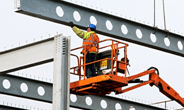Analysis

March 28, 2022
AGC: Construction Jobs Up, But Supply Chain Woes Loom Large
Written by David Schollaert
While February construction employment exceeded pre-pandemic levels in nearly two-thirds of US states, the Associated General Contractors of America (AGC) cautions further gains could be undermined if skyrocketing materials costs and delayed shipments postpone or cancel projects.
![]() “Construction is doing well at the moment in most states, but fast-rising costs may cause some owners to cancel planned projects,” AGC chief economist Ken Simonson said. “In addition, production and shipping delays are likely to slow down projects and the hiring associated with them.”
“Construction is doing well at the moment in most states, but fast-rising costs may cause some owners to cancel planned projects,” AGC chief economist Ken Simonson said. “In addition, production and shipping delays are likely to slow down projects and the hiring associated with them.”
The impact of the pandemic on the domestic construction sector cannot be overstated. We’re more than two years removed from February 2020, the month before the pandemic halted or canceled projects. And even though construction employment has increased in 32 states, 18 states and the District of Columbia have recorded declines.
Florida has added the most construction jobs since February 2020, up 14,100 jobs. It is followed by Utah (+13,600 jobs), Tennessee (+11,400 jobs), and Missouri (+9,500 jobs). Idaho had the largest percentage gain, up 13.1% (+7,200 jobs).
New York shed the most construction jobs over the last two years, with a loss of 26,500 jobs. It was followed by Texas (-19,700 jobs) and Pennsylvania (-16,000 jobs). The largest percentage losses were in North Dakota, down 6.8% (-1,900 jobs).
Construction employment in February increased in 39 states month on month, decreased in nine states and D.C., and was unchanged in Alaska and Louisiana. California added the most construction jobs, up 22,100 (2.5%) when compared to January. It was followed by Texas, up 5,900 (0.8%). Rhode Island had the largest percentage gain, 3.5%, or up 700 jobs.
Georgia lost the most construction jobs month-over-month in February, down 4,300 jobs, or -2.1%. It was followed by Ohio (-2,800 jobs), Pennsylvania (-1,600 jobs), and Alabama (-1,200 jobs).
Some of the contributing factors to rising materials prices – like the invasion of Ukraine by Russian forces – were hard to predict. But the AGC nonetheless urged federal officials to continue working to unsnarl supply chains and to limit supply disruptions. The group has also lobbied for greater price flexibility for contractors grappling with spikes in costs for key construction materials – notably when it come to diesel.
“Construction firms won’t be able to keep adding jobs in most parts of the country if rising materials prices turn every successful project into a financial loss,” AGC CEO Stephen Sandherr said. “Getting our supply chain moving efficiently again won’t be easy, but it is essential to the strength of the construction sector and the overall economy.”
By David Schollaert, David@SteelMarketUpdate.com







